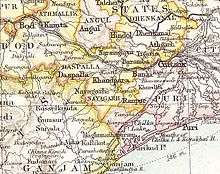Khandpara State
Khandpara State was one of the princely states of India during the period of the British Raj. It was located in present-day Nayagarh district, Odisha.
| Khandpara State | |||||||
|---|---|---|---|---|---|---|---|
| Princely State of British India | |||||||
| c. 1599–1948 | |||||||
 Flag | |||||||
 Khandpara State in the Imperial Gazetteer of India | |||||||
| Area | |||||||
• 1901 | 632 km2 (244 sq mi) | ||||||
| Population | |||||||
• 1901 | 77929 | ||||||
| History | |||||||
• Established | c. 1599 | ||||||
• Accession to the Union of India | 1948 | ||||||
| |||||||
The state was bounded in the north by the Mahanadi River. The main town was Kantilo, but the capital was at Khandpara (Khandapada).[1]
History
Founded by a former Raja of Rewah or by the Raja Raghunath Singh of Nayagarh, who had two sons, the elder son, Harihar Singh, became Raja of Nayagarh, and the younger, Jadunath Singh Mangraj, retained possession of four Garhs, or forts, as his share, viz. Kadua, Ghuntsahi, Sardhapur, and Khepada, all in Nayagarh.In 1599 A.D. jadunath singh managaraj is said to have defeated the chief then holding sway over the territory from agalpur to harichandanpur in khandpara & took possession of his territory . In the reign of Raja Narayan Singh Mangraj, Khandpara extended on the east up to Banki, on the west to Balaramprasad in Daspalla, on the north to Kantilo, and on the south up to Jogiapali in Nayagarh. State was initially part of Nayagarh State, founded by a former ruler of Rewa State, but became a separate kingdom in 1599 when Jadunath Singh Mangraj, the first ruler of Khandpara received the title of 'Mangraj' from the Maharaja of Orissa. The rulers were Rajputs of the Baghela or Vaghela dynasty. At the time when Padmanabha Mangaraj was the king of Baramba, the king of Khandapara attacked Baramba kingdom and captured Baramba kingdom.(Source:Feudatory States of Orissa: Bengal District Gazetteers by L. E. B. Cobden-Ramsay .)
Rulers
The rulers of Khandpara State bore the title of Raja. The emblem of the Khandpara royal family was the head of a tiger; state symbols were identical in neighboring Nayagarh State.[2]
Rajas
- 1599 – 1675 Jadunath Singh Mangraj, 1st Raja of Khandpara
- 1675 – 1709 Narayan Singh Mangraj
- 1709 – 1723 Balunkeshwar Singh Mangraj
- 1723 – 1732 Banamali Singh Mardraj Bhramarbar Rai
- 1734 – 1770 Bairagi Singh Mardraj Bhramarbar Rai
- 1770 – 1794 Niladri Singh Mardraj Bhramarbar Rai
- 1794 – 1815 Narasimha Singh Mardraj Bhramarbar Rai
- 1815 – 1821 Purushottam Mardraj Bhramarbar Rai
- 1821 – 1842 Krishna Chandra Singh Bhramarbar Rai
- 1842 – 1867 Kunja Bihari Singh Bhramarbar Rai
- 28 Feb 1867 – 1905 Natobar Mardraj Bhramarbar Rai (b. 1837 – d. 1905)
- 1905 – 26 December 1922 Ram Chandra Singh Mardraj Bhramarbar Rai
- 26 Dec 1922 – 15 August 1947 Harihar Singh Deo Mardraj Bhramarbar Rai (b. 1914 – d. 1977)
References
- Great Britain India Office. The Imperial Gazetteer of India. Oxford: Clarendon Press, 1908.
- Princely States of India